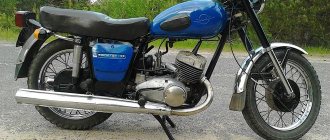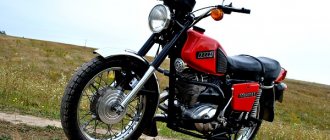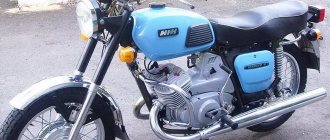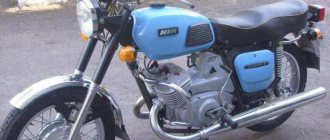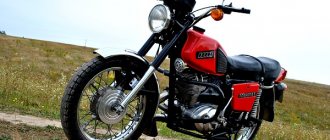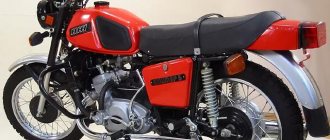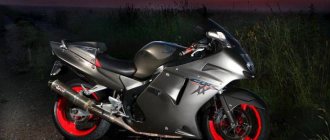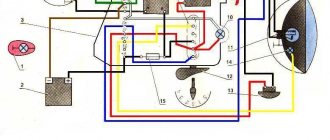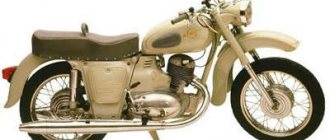We would like to note right away that motorcycles of the IZH family were the most democratic and affordable form of transport in the 80s, which gave freedom of movement to many young men and adult men. In those years there was no Internet or cable TV, so wiping your pants on the couch was unfashionable . But the wiring diagram for the IZH Jupiter 3 was read to the gills by these same young men, which many adult aunts and uncles recall with nostalgia today.
Legend in factory configuration
Review
Classic transport has always been valued since the USSR, and 20 years ago Jupiter 5 was one of the best.
Today, most riders ride foreign fast motorcycles, but occasionally you can meet a former legend of the 80s and 90s. In those years, only his brother Planet 5 competed with Jupiter, but he could not compare with the motorcycle in terms of characteristics. Their main difference was the difference in cylinders, and therefore power. If we continue to compare these two competitors, we can highlight the fact that both models had almost the same data. For example, they had one tubular frame, and a special subframe was installed to better secure the rear wheel. In general, the entire design of Jupiter 5 was quite standard and simple, the engine was attached to the frame, the fuel tank was located above, and the headlight and dashboard were installed on the steering wheel.
In the photo of Izh Jupiter 5 you can see that below the seat there are two compartments with protection. These were glove compartments, each of which was intended for a specific purpose: the right one was for tools, and the left one housed the battery. There were also 2 exhaust pipes installed that ran through the entire motorcycle. Sometimes the pipes got hot and could cause a burn, but the manufacturer installed them below the footpegs to keep the passenger as safe as possible.
Even the first models of the Izh Jupiter 5 motorcycle had simple drum brakes with a mechanical drive, but subsequent modifications received a front disc brake with a hydraulic drive.
Refinement of the exhaust and intake system
Tuning of the IZH Jupiter-5 motorcycle is carried out by improving the intake part. The main disadvantage of this system is the absence of a reed-type valve and the presence of only one carburetor on the standard engine. This element does not allow you to develop high speeds and power. The optimal solution would be to install a pair of identical carburetors along with two “house” type reed valves.
It will be necessary to make new intake pipes specifically for each cylinder with the possibility of installing housings under the “petals”. The parts ensure that the fuel mixture is supplied only to the internal part, which has a positive effect on filling the cylinders with an increase in power. Carburetors can be taken from two-stroke foreign bikes of identical volume, the domestic “Ural” or K-68. You will also need to select jets for the volume of the motorcycle’s power unit.
When tuning IZ Jupiter-5, many owners believe that it is appropriate to install a forward flow with a beautiful exhaust pipe. Experts categorically advise against doing this. This solution leads to an increase in fuel consumption and a decrease in power. The exhaust system should consist of a pair of resonators. Combining two exhaust elements into one unit is not allowed. If you want to make the sound of exhaust gases quieter, install muffling nozzles.
Repair and tuning
The products of the Izhevsk plant have never been famous for their reliability. But there is also an advantage in this - being the first motorcycle for a novice biker, some “Izhak” acted as a “learning desk”, helping to learn not only driving, but also independent maintenance and repair.
Spare parts
Finding them is not difficult, because at one time the Izhevsk plant riveted a fair number of motorcycles. The prices are low, but in some cases it is cheaper and easier to buy a “donor”, from which you can remove everything you need as needed.
Tuning
It is not easy to somehow modify a Soviet bike. Typically, owners reduce all changes made to visual tuning. Sometimes the carburetor is replaced with a Japanese or Chinese one - this relatively inexpensive operation helps avoid many potential problems.
IZh Planeta-3. Rework
IZh Planeta-3. Rework
Message by Hedgehog » February 14, 2010, 07:09 pm
I, in principle, if I put my mind to it, could have bought a heavy weight a long time ago, made something good out of it with my own and not my own efforts, many people do. but it seems to me that this would simply be disrespectful to my PLANET. This is my first motorcycle, and almost the only one I’ve ridden in my life, but it’s older than me, it carried me in its stroller since I was a child (when my grandfather rode it), I have a lot in common with it.
And from the age of 14, when my grandfather somehow, having already bought himself a car, hinted that when I got my license at 16, he would give it to me, there was not a day when I didn’t think about this hack. That's exactly what it's about. Because due to the small financial resources of my parents, I never dreamed of buying a motorcycle. And this one is like an inheritance to me.
For many reasons (the boys and acquaintances were breaking up, there was no money, I was studying at the institute), I only took him 2 years ago. And he took up it. at first it's easy. but then I decided to make something worthwhile out of it. Of course, this won’t be a chopper with parts made to order or in a workshop, I don’t have any such machines, etc., and I don’t really have any money, I mean the kind that can be spent decently on motorcycles. So often I simply deprive myself of some pleasures and invest my money in spending money. These are not too big expenses, but the main thing here seems to me to be the result. And I will bring it to mind! But then I’ll think about the heavy weight.
More. Before writing, I want to express my deep gratitude to my friend Tolik (Chepa) for helping me so much. Without him, I wouldn't have managed anything. Thank you Tolyan, you are a true friend!
Here are some photos from the stages of my remodel. I’ll say right away - don’t blame me, because this is all being done due to a catastrophic shortage of banknotes, but with a great love for motorcycles and everything related to motorcycles.
I found a new still sealed crankcase in the corner of my grandfather’s garage, it was lying in a box, sealed for about 20 years, I took the cover off from there and installed it for myself, it looks nicer.
Notes
- ↑ 1 2 3 4 5 V. Bonstedt.
“JUPITER” new road motorcycle // “Behind the Wheel”: magazine. - 1961. - No. 8. - P. 16-17. - M. G. Ginzburg.
Construction and maintenance of motorcycles. — second edition, revised. - Moscow: Mashgiz, 1963. - 319 p. — 215,000 copies. - B.F. Demchenko, G.S. Mikryukov.
Motorcycles with the Izh brand. - Moscow: DOSAAF USSR, 1982. - 160 p. - ↑ 12
How many and what kind of Izhes? // “Behind the wheel”: magazine. - 1986. - No. 10. - P. 8. - M.P.Isaev, V.A.Zabelin.
Motorcycles Izh-Jupiter and Izh-YUK. Instructions for care and use. - Izhevsk: Mashinostroitelny Zavod, 1964. - 158 p. - L. Komzikov.
Side trailer BP-62 // “Behind the Wheel”: magazine. - 1961. - No. 8. - P. 17.
Cylinders
In order to improve the filling of the cylinders in both engines, the flow sections of the windows have been changed and the valve timing has been increased. This is clearly visible in Fig. 2. where the cylinder developments are presented. The IZH-Jupiter 3 engine uses a two-jet purge scheme, rather than a four-jet one. as it was on IZH-Yu2.
Rice. 2. Cylinder scans: on the left 2a - IZH Jupiter 3, on the right 2b - IZH Planet 3. The dotted line shows the windows of the IZH-Yu2 and IZH-P2 engines, respectively.
The thermal regime of engines of previous models, especially IZH-Yu2, was quite intense. Because of this, if the ignition or carburetor adjustments were violated, detonation sometimes occurred, the piston jammed, and the exhaust pipes darkened. To reduce the thermal stress of new engines and eliminate unpleasant consequences, the cylinders and heads were equipped with more developed fins, and on the Jupiter 3 model, in addition, the length of the exhaust channel in the cylinder was increased. Now the exhaust gases entering the exhaust pipe have a lower temperature.
Motorcycle service
Unlike other models, both domestic and foreign (see the article for the wiring diagram of the Delta moped), the IZH Jupiter 3 is distinguished by its enviable survivability.
Here are a few instructions for resuscitating a motorcycle that has stood motionless:
- It is enough to replace or clean the candles yourself;
- Adjust the ignition;
- Replace high-voltage wires from the coils with spark plugs;
- Change the engine oil;
- Install a new battery or charge the existing one.
A modern scheme, more understandable to the younger generation.
And it will start and drive. And this is its distinctive feature, which is well known to the generation of the 80s. You can restore the old paintwork, reupholster the seat, or polish the chrome parts to a shine later, the main thing is its durability.
Advice: wiring IZ Jupiter 3 after long-term storage also requires close attention. Inspect it for abrasions and damage to the insulation. If any, replace the wires. Don't repair, just replace. How to do this - see the article Original Java 634 wiring.
In the photo, the restored IZ Jupiter 3 (on the right) looks no worse than modern models.
In the video below you can get acquainted with the features of this model. It should be noted that the cost of restoration is quite affordable for most, and the difficulty lies only in the lack of spare parts and the need to modify those found from other models.
Motorcycle design
But structurally the motorcycles of these modifications did not differ from each other. All components of the motorcycle were mounted on a tubular frame. To provide suspension for the rear wheel, there was a subframe at the rear of the frame, attached to the frame by a non-rigid bolt connection.
A power unit with a gearbox and a steering column equipped with a telescopic fork were installed on the front part of the frame. The fuel tank was located above the engine, and in front of it was the steering wheel, dashboard and headlight.
Behind the tank, the entire upper part of the motorcycle was allocated under the seat, with a rear fender with a brake light attached to it. Below the seat there were two glove compartments. The left one was for the battery, and the right one was for tools.
The rear wheel was installed on the existing subframe. To provide its suspension, the subframe, in addition to the non-rigid bolted fastening, was connected to the frame by means of spring-loaded oil shock absorbers. The springs had three-position adjustment, which provided a change in the rigidity of the rear suspension. The rear wheel was driven by a chain drive.
Exhaust pipes extending from the engine stretched along the entire motorcycle. To protect the driver and passenger from possible burns, the pipes were attached under the running boards.
The motorcycle was equipped with two-cam drum brakes with mechanical drive on both wheels. Subsequently, some versions were equipped with hydraulic front disc brakes.
Suspension upgrade
The standard suspension of the motorcycle in question is quite reliable and has good maintainability. However, its characteristics can be improved somewhat. To do this, perform the following steps:
- Install adjustable gas shock absorbers. They are easy to find in specialized stores. As a result, ride comfort and vehicle stability on the highway are increased.
- Change the front fork. Most often, this process is accompanied by reworking the fastening of the part.
- Install an ergonomic steering wheel.
Two carburetors on IZ Jupiter
Among all the various modifications for the two-cylinder Izh, the installation of two carburetors on the motorcycle engine stands out. One for each cylinder. This is done in hopes of increasing engine power by improving the filling of each cylinder. The power does increase, but at most by a couple of horses.
Therefore, on most two-stroke vehicles there is an intake resonator between the carburetor and the filter. It is a plastic box into which part of the mixture is spat out. This device is not available on Jupiters, because there is no particular need for it due to the length of the “pants” and the peculiarities of the two-cylinder engine. While one cylinder is making its stroke, the second one sucks in the mixture from the carburetor plus the part that was reflected from the skirt of the first piston.
In addition, installing a reed valve will improve cylinder filling at low and medium speeds, and fuel consumption will be slightly reduced. The Jupiter cylinder is approximately equal to the volume of 175 cm3, so the reed valves can be supplied from sunrise 3m-01 or made from a turner according to a sample. Carburetors can also be taken from Voskhod (K-62V, K-65V) or from Java 638.
In addition to installing the valves, the pistons will also need to be modified. A hole must be made on the piston skirt on the inlet side, as shown in the figure. This is necessary in order to reduce the inlet resistance necessary for the operation of the petals.
To operate two carburetors, you will need a tap with a double and a common throttle handle for both cables. These parts can be taken from the Urals or picked up from other motorcycle models.
After installing all the parts, it is necessary to configure and synchronize the carburetors. Otherwise, overheating and wear of one of the cylinders, as well as severe vibration, may occur.
Tuning the Izh motorcycle. BSZ on Izh Jupiter
The main problem with the Izh Jupiter motorcycle engine is the standard contact ignition system. Any owner of Jupiter sooner or later faces the problem of failure of one of the cylinders due to a change in the gap in the contacts or failure of the capacitor. Adjustment helps, but usually not for long. This problem can be radically solved by installing a contactless ignition system on a motorcycle.
Single-channel BSZ.
There are probably many options for BSZ design, but we won’t consider them all. Let's focus on the simplest, and probably the most common option in our country. There is no motorcycle market or motorcycle store nearby where you can buy a factory-made BSZ, and there is no turner with a machine nearby either. We will proceed from this.
Minimum set for installation
But we can’t do without a minimum set, so before you start work, you need to stock up on the following components, which are sold in any auto shop or car market in our country:
1. Switch from VAZ 2108
2. Hall sensor from VAZ 2108
3. Set of wires for BSZ from VAZ 2107 (from distributor (Hall sensor) to switch)
4. Two-terminal ignition coil (from an Oka or Gazelle car with a ZMZ 406 engine)
5. Two automotive silicone high-voltage wires of the required length with caps for spark plugs (you can buy a kit for a VAZ and take it from there, you can simply find used wires, after first making sure they are working)
Next, in addition to the components, we will need a small flat piece of sheet steel 1-1.2 mm thick to make a modulator and a plate for the Hall sensor. I warn you right away that stainless steel or non-ferrous metals are not suitable for the manufacture of the modulator, since they are not magnetic materials. To make a plate for the Hall sensor, you can use any material of sufficient strength.
Tools you may need are a drill with drills, files, a chisel, a hammer and other tools that, as a rule, are found in any garage.
Rework process
We dismantle the old ignition system. We remove the plate with contacts, capacitors, ignition coils with high-voltage wires from the motorcycle. We install the switch in the right glove compartment.
We attach the ignition coil to the frame under the tank. We connect the wiring connector to the switch, connect the black ground wire from the connector to ground. We connect the wire from terminal No. 1 of the switch connector to one of the coil terminals. We connect the second terminal of the coil to the old wiring, to the wire to which “+12V” is supplied when the ignition is turned on. In the old wiring, this wire connected both ignition coils. From it we pull an additional “+12V” wire to the switch, which we connect to the 4th wire in the connector. We carefully isolate everything. We insert the wire with the connector to the Hall sensor into the cavity of the generator.
You can check the functionality of the system. We connect the Hall sensor to its connector, connect the high-voltage wires to the coil and to the spark plugs. We provide reliable weight to the candles. Turn on the ignition and pass a metal object (you can use a flat screwdriver) through the Hall sensor slot. The spark plugs should spark. The scheme is working. (If there is no spark, then something is connected incorrectly and everything needs to be checked again.) Now it remains to supply a spark at the right time to the cylinders, for this:
We make a plate for mounting the Hall sensor.
There are no requirements for the shape of the plate as such. It must ensure that the Hall sensor is mounted at a certain distance from the armature axis.
The approximate markings of the central hole and cutouts for the mounting screws to the generator can be copied from the old, removed contact mounting plate. We mark the Hall sensor mount in such a way that the distance to the rear wall of the sensor through the magnet slot from the center of the armature is around 60-65 mm. You can machine additional grooves in the plate being manufactured in the attachment to the generator to ensure slight rotation of the plate around its axis (to facilitate setting the ignition timing), but you don’t have to do this, but simply attach the plate tightly to the generator. We drill, sharpen, adjust in place, install the plate with the Hall sensor on the generator.
We make the “Butterfly” modulator
The next point is to accurately measure the distance from the center of the armature to the back wall of the Hall sensor through the magnet slot. We take this distance as the basis for the modulator being manufactured. When clean, the radius of the modulator should be two millimeters less than the measured distance; this is necessary for the gap between the sensor wall and the edge of the modulator.
We cut out a square blank from sheet metal with a side length equal to the distance from the center of the anchor to the rear wall of the house multiplied by two. Mark the center of the square. From this center, inside the square, we mark one circle of the required radius, and a second circle with a radius of approximately 15 mm. We mark the sectors inside the larger circle. Draw a line through the center of the circle. Using a protractor or triangle, measure an angle of 60 degrees from the center and draw a second line through the center. The workpiece produces four sectors. Two at 60 degrees and two at 120 degrees. We mark narrow sectors with a pencil or felt-tip pen for disposal. Drill a hole with a diameter of 8 mm in the center of the marked square blank. Carefully cut out a circle with a chisel. The circle marking line remains on the workpiece. Next, insert the bolt into the hole, clamp the workpiece with a nut on the back side and insert it into the drill chuck. Turn on the drill and use a file or stone to smooth out the unevenness and runout of the outer edge of the workpiece obtained from the chisel. Grind down to clean size. The result is a perfect circle of the desired diameter. We clamp the workpiece in a vice. Using a hacksaw or grinder, carefully cut out the sectors to the marked inner circle. We cut out the inner part of the sector along the marked small circle with a chisel and grind it with a file. The modulator is almost ready. It is necessary to check that the opposite cuts are on the same straight line. This is necessary for synchronism in the ignition of the cylinders (at the same distance from TDC).
It is enough that at least one pair of slices lies on the same straight line. We mark these sector slices to distinguish them from non-working slices. The fact is that a spark is formed at the moment the curtain is OPENED in the Hall sensor. That is, when the passage of the metal part through the sensor ends and the cutout begins. This is an important point and must be taken into account when installing the modulator on a motorcycle. The crankshaft rotates clockwise, so we place the working edge – coming out of the sensor. Regarding the non-working incoming edge, the working one is located on the LEFT.
We install the modulator on the generator armature. This may require adjustment. Usually a set of several washers is placed either under the modulator or under the sensor to align the shutter and the sensor slot. The curtain should run approximately in the center of the slot. The rotating modulator should not touch the walls of the sensor.
Setting the ignition timing.
To set the ignition timing, you can use devices to determine the spark timing, but we will assume that there are no devices. We determine the moment of spark by the spark itself. To do this, we use the standard indicator that comes with the motorcycle to set the piston to a position of 2.8 mm to top dead center. If there is no indicator, then using any available methods we set the right piston to the position 2.8 mm before TDC. The modulator should not be tightened on the anchor. Turn on the ignition and turn the modulator clockwise until a spark breaks out in the spark plug. We repeat the operation and remember the position of the modulator relative to the armature when the spark passes. We tighten the modulator, being careful not to rotate it relative to the found position. (This is where the slots on the plate come in handy)
Next comes checking and adjusting the alignment of the working edges of the modulator so that the spark is on both cylinders at the same distance from TDC. While turning the crankshaft, we check once again that the ignition timing is set correctly for the right cylinder, remembering the position of the indicator at which the spark occurs. We reinstall the indicator in the left cylinder, set the advance to 2.8 mm from TDC according to the indicator and catch a spark in this position. If everything matches and the spark is where it is needed, we can congratulate you, the tuning is completed, wrap the spark plugs, start it and enjoy the now smooth operation of the engine at all speeds.
If your spark appears earlier or later, then perform the following steps.
Option A. If the spark appears on the left cylinder later than the position of 2.8 mm before TDC. Right on the motorcycle, it is necessary to slightly file the curtain that comes out of the Hall sensor with a file in order to achieve an earlier appearance of the spark. In this case, do not unscrew or remove the modulator, otherwise you will have to install everything again!
Option B. If the spark appears on the left cylinder earlier than on the right one, that is, without reaching the position of 2.8 mm before TDC. Loosen the modulator mounting bolt and set the ignition timing first for the left cylinder. Next, we repeat all the steps described above, starting with setting the ignition timing from the left cylinder, plus use option A to fine-tune the right cylinder.
Petukhov Nikolay
The editors of the magazine would like to thank Nikolai Petukhov for kindly providing materials for the article.
If you have something to share with readers and would like to publish your story or photo report about your travels on our website, please send the materials to:
This might be interesting
- On bicycles through the mountains This is a report on a journey by bicycles through the Caucasus Mountains of completely unprepared people. Read this article and you...
- Car loan. Article 5. Reviews about car loans It’s up to you to decide whether to take out a car loan or not. We publish reviews from consumers and car owners who at one time...
- Travel to Sevastopol from Krasnodar to Izha in 2012 The road, it equalizes everyone, and it doesn’t matter at all who you are in your main life,…
Familiar problems
Reviews from owners indicate that, regardless of the version and year of manufacture, the Izh Planet-3 motorcycle had the same disadvantages:
- Engine vibration associated with its design features. Almost all single-cylinder engines suffer from this.
- Problematic electrical equipment. Almost identical to the Jupiter of the same years of production, the 6-volt wiring installed on Izh Planet-3 was not of very high quality. An insufficiently powerful generator created problems when driving at night.
Completely eliminating engine vibrations is almost impossible. Even serious engine tuning does not completely solve the problem. You have to put up with this feature of technology. As for electrics, motorcycle lovers who are interested in tuning Izh Planet-3 often ask the same questions:
- How to detect ignition system malfunctions?
- What to do if charging is lost?
- How to replace the relay regulator?
- Does it make sense to install electronic ignition?
- How to replace a failed generator?
- Where can I find the wiring diagram for Izh Planet-3 at 6 volts?
- How to install BSZ?
These questions are countless and it is simply impossible to answer them in one review article. This requires digging deeper. And therefore we will try to answer as briefly as possible.
- Since the wiring diagram on Izh Planet-3 was repeatedly changed even depending on individual series, one cannot count on an exact match of its description. Sad but true.
- Replacing electrical wiring, switching electrical equipment operating from 6 volts to 12 volts and installing contactless ignition are completely justified steps to improve the performance of a motorcycle. After such modernization, ignition installation is simplified, and engine operation becomes more stable. At the same time, you will know exactly how the electrical circuit of your Izh Planet-3 works!
But it’s clearly not worth getting down to business without the necessary skills or suitable tools. As for DIY tuning enthusiasts, for them the Izh Planeta-3 motorcycle is an unplowed field for activity. There is room to expand here. Go for it!
If you found the article useful and interesting, continue to expand your horizons by getting acquainted with the history and structure of popular technology. Find out what might be interesting about tuning Izh Jupiter-5, or what technical characteristics the Ant cargo scooter had. Stay on our website!
Previous entry Motorcycle Izh Planet 7 - technical parameters, review Next entry Motorcycle Tula - technical characteristics, review
Improving the Izh Jupiter 5 engine
If you decide to do the tuning of the Izh Jupiter 5 with your own hands, and at the same time your eyes are focused on the engine, be prepared for the fact that you will have to do some serious work. Basically, modernizing a motor means increasing its characteristics and, accordingly, power. Any tuning of the Izh Jupiter 5 engine implies two options:
- increase in volume;
- increasing engine speed.
With the first option, you will need to spend a considerable sum, because in order to increase the volume of the engine you will have to bore the cylinder, buy another piston and, if necessary, make another crankshaft. But with the right approach to such tuning, the increase in power will be noticeable. The downside of this method is that the cylinder is too fragile and may not be able to be bored.
Japanese pistons for Jupiter 5
In the second case, as the speed increases, you will have to adjust the valve timing. As you know, the timing of the distribution is controlled by the windows in the cylinders, so if you can bore these windows, the motorcycle will increase in speed and, accordingly, power. But be careful when making such an upgrade, because if you drill the windows incorrectly and add a different amount of fuel mixture, the engine will not only lose power, but will also have increased fuel consumption.
Motorcycle modifications
The basic model had the index IZH 6.113 - 010 - 01, and the version with a side stroller - 6114 - 010 - 01. The “Lux” modifications were also produced (cradle, spare wheel, toothy tires, fairing, protective arches, trunk) and “Tourist” ( the same thing, but without the fairing, trunk and arches). Subsequently, the bike was modernized many times, receiving a different carburetor, a disc front brake, and a more energy-intensive fork with pneumatic adjustment. There is also a version with a cargo side trailer, but this is vanishingly rare these days. Jupiter 5 of the transitional model also comes across on sale, but this definition usually hides just one of the early modifications.
What do the owners say?
As reviews show, tuning the IZH Jupiter-5 with your own hands is quite possible. It is not limited to the manipulations indicated above. Since changing one unit leads to the need to transform the associated blocks, users recommend strengthening the chassis, balancing the wheel rims, and strengthening the pendulum. It is recommended to equip the standard frame with stiffeners. In addition, when modernizing, they often install disc brakes, a thicker front fork, and also paint the motorcycle in original color combinations. If you approach the tuning process correctly and competently, the result can exceed your wildest expectations.
Notes
Wikimedia Foundation. 2010.
See what “Izh Jupiter-2” is in other dictionaries:
- This term has other meanings, see Jupiter. Jupiter Superior depicted ... Wikipedia
— “Jupiter and Thetis” (“Jupiter et Thétis”), artist Jean Ingres, 1811, oil, 330×257 cm. This term has other meanings, see ... Wikipedia
— “Jupiter and Thetis” (“Jupiter et Thétis”), artist Jean Ingres, 1811, oil, 330×257 cm. Jupiter (Latin Iuppiter) in ancient Roman mythology, the god of the sky, daylight, thunderstorms, king of the gods, supreme deity Romans Husband of the goddess Juno. Corresponds... ... Wikipedia
- (Jupiter). Roman deity corresponding to the Greek Zeus. He is the king of heaven, on whom all celestial phenomena depend, the ruler of the world, who controls the fate of peoples and states. He was considered the main patron of the Roman state; him... ... Encyclopedia of Mythology
JUPITER (astrological sign G), planet, average distance from the Sun 5.2 a. e. (778.3 million km), sidereal period of revolution 11.9 years, rotation period (cloud layer near the equator) approx. 10 h, equivalent diameter approx. 142,800 km, mass... ... Encyclopedic Dictionary
Hai! If you are only interested in the electronics of this motorcycle, then you need our section “Motorcycle diagrams”. Those who are looking for a description with a photo based on reviews and technical characteristics of the Izh Jupiter 2 motorcycle, which you can buy today, then you have come to the right place. The article is devoted to the most important features of this bike, which has survived more than a dozen difficult years. Our team tried to fully reveal the advantages and disadvantages of this two-/three-wheeled vehicle.
Description of Izh Jupiter Second generation with photo
The above-mentioned iron horse is a middle-class road bike, the operation of which is designed for roads with a variety of surfaces. The production of this steel horse was mastered at the Izhevsk machine-building enterprise, located in distant Udmurtia. This motorcycle became a continuation of the line of multi-purpose middle-weight motorcycles produced in Soviet Russia. The very first representatives of the mass series came off the assembly line in the mid-1960s. The steel horse was produced until 1972. The bike became the embodiment of the desire of USSR design engineers to create a two-cylinder motorcycle.
It should be noted that as the first Udmurt iron horse with such a fast engine, the motorcycle turned out great. It had at its disposal a power of 19 horsepower with a rather modest, for that time, engine capacity of 347 cc. In addition, a very good lead-acid battery was installed on the two/three-wheeler.
Reviews about the Izh Jupiter 2 motorcycle in past years were mostly positive. However, over time, domestic motorcycle enthusiasts changed their views on the reliability of the iron horse. This is all due to the developers' miscalculations in the bike's electronics. His ignition timing was often off. And the bearing under the rotor part of the generator showed accelerated wear, which significantly upset the owners of the motorcycle. Not every village owner wanted to buy a second-generation Yupak.
It is curious that the above Izh, despite its short production history, was produced in a variety of modifications. Classic singles, models equipped with a sidecar, and even anniversary motorcycles rolled off the assembly line. In the last year of production, the world saw a transitional model that received eighteen-inch wheels, as well as beautiful glove compartments. The latter bore the typical later inscription with the name of the series.
Izh Jupiter 2 technical specifications
The maximum recommended speed of the bike is 110 km. at one o'clock. Engine type: two-stroke, two-cylinder, air-cooled. The piston diameter is 61.75 mm. The piston stroke reaches 58 mm. The engine capacity is 347 cc. The compression ratio is 7 to 1. The type of fuel supply is through a K36Zh carburetor. The proportion of gasoline mixed with oil is 25 to 1 (during break-in - 20 to 1). Gearbox - 4 steps. The main drive type of the motorcycle is chain. The brake system is both front and rear drum type. The base of the Jupiter 2 motorcycle reaches 1430 mm. The volume of the fuel tank is 18 liters. Dry weight
The Soviet motorcycle industry was diverse and replete with various models of motorcycles. The IZH motorcycle brand was produced from 1929 to 2008. The plant where they were created was located in the glorious and old city of Izhevsk. And one of the most popular motorcycles in the USSR was the IZH-2 “Jupiter”. Let's take a closer look at this model.
"IZH Jupiter-2" - characteristics
All the bells and whistles, looks, innovative details don't matter much
The only thing you should pay close attention to is the technical specifications. They can tell you about the bike what the shine hides
And so, the main center of any vehicle, and a motorcycle is one of them, is the engine. Therefore, the first thing you need to look at is the motor. IZH 2 Jupiter has a gasoline power unit, which is classified as a two-stroke system. This means that the pistons are lubricated by supplying the main fuel. That is, right at the gas station, in addition to gasoline, engine oil must also be poured into the fuel tank. At first glance there are a lot of details, but once you get used to it, you don’t notice it. The Jupiter engine has only two cylinders.
Their total volume is three hundred and forty-seven cubic centimeters. The IZh engine is capable of developing a power of nineteen horsepower. This is normal for a light motorcycle. The good old carburetor is responsible for supplying fuel. You should not forget the main thing: practical characteristics. “IZH 2 Jupiter” on relatively flat terrain is capable of reaching a speed of one hundred and ten kilometers per hour. Fuel consumption is low: four and a half liters of “eightie” per hundred kilometers of working distance. Jupiter is cooled using air currents. Not very effective, of course. But it was relevant for that time.
Main disadvantages
All modifications were marked with a quality mark and were generally reliable. Owners of equipment made at the Izhevsk Machine-Building Plant were given headaches by:
- A weak generator, the power of which was not enough to power all electrical appliances at night.
- An ignition system made according to a separate circuit for each cylinder. In general, it is quite reliable, but setting the ignition evenly on the Izh Jupiter 3 is not an easy task.
- The electrical wiring is not of entirely satisfactory quality. Owners of new cars often complained that the wires were mixed up at the factory.
Nevertheless, the popularity of the model was great, and if anything stopped potential buyers, it was the fairly high price. Over the course of a year, the plant produced over 250,000 cars that went on public sale. The successful design became the basis for the creation of the following modifications, the latest of which was Izh Jupiter-5.
External tuning Izh Jupiter 5
Appearance has always played an important role for the owner, so anyone who wants to modernize their vehicle immediately takes on minor changes in appearance, because this requires a minimum of funds and a great desire to stand out. Basically, if you look at the Izh Jupiter 5 tuning photo, you can see that most are trying to transform their bike into a sports motorcycle. Jupiter 5 itself looks like a sports class, but modern models have a more attractive appearance. External tuning is divided into several processes:
- lightweight design;
- frame extension;
- installation of a new seat;
- chrome plating of some elements;
- installation of fairings.
If you decide to install new fairings on your motorcycle, you can use two types: a new unique part or a used fairing from another motorcycle model. In the second case, you will have to change the fastenings of the fairings, and only then will it fit. This option is the most popular, because buying a custom-made fairing will be very expensive.
You can also see a large review of the IZH Jupiter 5 motorcycle, its characteristics and photos.
Another equally popular type of tuning is chrome plating of parts. If you find metal parts on your motorcycle, make sure they shine by chrome plating. The following parts can be chromed: exhaust pipe, wheel rims, engine block and fork. You can tune other elements at your discretion.
Further, not only beautiful, but also useful tuning will be to lighten the age of the motorcycle. To do this, all unnecessary parts are removed and, if necessary, replaced with lighter analogues. And finally, installing a new seat can be an excellent option for external tuning. You can go two ways: reupholster the existing seat with leather or order a new seat from a sports motorcycle. You may also have noticed that owners often style their Jupiter 5 as a Japanese motorcycle Suzuki Bandit 650, taking from it not only its appearance, but also other tangible details.
Modifications
IZH "Jupiter" with index "5" came off the assembly line in 1985, two years earlier than the IZH "Planet-5" model. The appearance of the first Jupiter-5 was almost completely identical to its predecessor, Jupiter-4.
But the then new engine had slightly reduced power, but increased torque. Among the visible changes, Jupiter-5 was distinguished by a different finning of the cylinders, as well as a new flange mounting of the exhaust pipes.
IZH "Jupiter-5" was a middle-class motorcycle designed for traveling on roads with various surfaces. Three modifications of this motorcycle were produced.
The standard version was a modification without a side trailer, but equipped with fastenings for it, as well as a modification already equipped with a side trailer - a motorcycle with a sidecar.
The second modification was “Tourist”. This motorcycle was equipped with a side trailer; in addition, it had a spare wheel with increased lugs. This modification was designated as IZH “Jupiter-5T”.
The third modification was designated “Lux”, or IZH “Jupiter-5L”. This motorcycle was not equipped with a side trailer, and there were no fastening elements on the motorcycle for it. But it was equipped with a small fairing, there were also knee roll bars and a towed luggage rack.
Recommendations
When tuning IZ Jupiter-5, you can make two-section “seats” yourself. A base is cut out of thick plastic to give the workpiece the required configuration. The structure is covered with a thin layer of foam rubber for furniture, then the future seat is covered with leather.
At the next stage, the tail section is changed:
- The desired shape is cut out of construction foam.
- The resulting figure is glued in layers using epoxy glue.
- After the composition has dried, the foam is cut out and the residues are removed using a solvent.
This shank lends itself perfectly to priming and painting. The rear part of the frame is welded to fit the resulting new part. External tuning of IZH Jupiter-5 includes replacing standard tires with sports road counterparts and installing new mirrors. This will give the bike a modern look and will have a positive effect on improving visibility. In addition, they install a dashboard from Chinese mopeds, control panels on the steering wheel, xenon light elements, LED turn signals and brake lights.
Tuning Izh Planet Sport
Making changes to the design of a motorcycle is impractical for a number of reasons:
- The resource of many components and assemblies is small. For this reason, it is almost impossible to improve their characteristics without causing damage.
- An Izh Planet Sport 350 restored to its original condition is valued significantly higher than its tuned versions.
However, if there is a desire, something can be done. Many athletes participating in cross-country or circuit racing competitions modified the Izh Planet Sport engine, making various changes to its design. A frequently asked question is how many cubic meters can the engine capacity be increased by.
Engine tuning (boosting)
When boosting the engine, the sports team masters altered many things, from the connecting rod and piston group to the exhaust system. The maximum that could be obtained by pressing in a liner from a CZ 500 and using the piston that came with it was a little over four hundred cubic centimeters of working volume.
But such boosting of the Izh Planet Sport engine requires serious professional skills and sophisticated equipment. The thin walls of a standard cast-iron sleeve pressed into an aluminum cylinder do not allow the engine to be bored up to 500 cc.
The exhaust system cannot cope with the removal of the increased volume of exhaust gases, and the support bearings cannot cope with the increased loads. All the talk that there was a factory version of the Izh Planet Sport 500cc is nothing more than a fairy tale. But boring a cylinder is not the only way to increase power and add agility to a motorcycle.
DIY tuning
Installing a new carburetor is a proven way to improve the performance of the Izh Sport without making significant changes to the design. Over the years, Mikuni has released many new, increasingly advanced models with a diffuser diameter of 32 mm.
Engine tuning can be done in other ways without affecting its mechanical components. Starting and stable operation of single-cylinder engines has always presented certain problems, which can be solved by installing electronic ignition on the Izh Planet Sport. Such kits are produced by several manufacturers, and their installation does not take much time.
When using BKSZ with power units of other modifications, you should be very careful. When installing the ignition from a Minsk motorcycle on the Izh Planet Sport, you must remember that the crankshafts of the engines of these machines rotate in opposite directions. The wires going from the coil to ground and the switch will have to be swapped. Such an engine modification is quite justified.
Motorcycles "Java"
Another legendary Jawa motorcycle dates back to 1929. This brand of road transport belonged to a Czechoslovak company and was the dream of many Soviet motorcycle enthusiasts. Motorcycles were used not only for everyday travel, but also participated in various racing competitions. In the 21st century, the production of Java has not stopped; some models are still in demand.
Jawa 350 Classic
The motorcycle is based on a 2-cylinder, 2-stroke system with a 4-speed gearbox. There is no connection between gasoline and oil thanks to a separate lubrication system. The motorcycle frame is strong, which allows you to load motor vehicles up to 200 kg. It is possible to attach a car seat.
If we compare the Jawa 350 Classic 638 model with others, more expensive and equipped, it wins in several respects: maintenance is simple and inexpensive, fuel consumption is low, spare parts are available for sale at a low price.
Technical characteristics of "Java" 350 classic:
- dimensions – 2110×750×1070;
- engine capacity - 343.5 cubic meters. cm;
- power – 23.1 l. With.;
- maximum speed – 125 km/h;
- gasoline consumption per 100 km – 4 liters;
- manual gearbox.
Jawa 350 Classic Sport
“Classic Sport” is an improved version of Jаwa 350 Classic. It was presented in 2015 at the Moscow exhibition “Motopark”. You can distinguish the model from other Java motorcycles by the “outdated” design of London in the 60s, when street motorcycle racers converted inconvenient and bulky motorcycles for themselves, removing everything unnecessary. The two-wheeled vehicle turned out to be light and maneuverable, with streamlined elements.
Jawa 350 Classic Sport is designed for solo travel and is equipped with one comfortable seat. The low steering wheel allows you to comfortably take the position of the rider, fully concentrating on the ride. The “rarity” of the motorcycle is reminiscent of its classic elements: a wide chrome exhaust pipe, a round headlight and a traditional red body color.
The motorcycle has a lot of advantages that make for a comfortable and maneuverable ride: a 343 cc engine, a separate lubrication system, a reliable disc-type brake system, a laconic dashboard and an automatic starter.
Specifications:
- engine capacity – 343.5 cubic meters;
- number of cylinders – 2;
- number of cycles – 2;
- power – 23 l. With.;
- maximum acceleration speed – 125 km/h;
- gasoline consumption per 100 km – 4 liters;
- air cooling system.
Jawa 350 Lux
The presented model is a classic version of a street class road motorcycle. It combines elements of older models, but also has individual modern features. The front of the motorcycle has a classic single headlight, and the electronic instrument panel is simple and understandable even for novice motorcyclists.
The basis of the two-wheeled design is a strong steel alloy frame. Its rigidity improves maneuverability on uneven roads, makes the vehicle maneuverable and increases load capacity. The holistic appearance of the Java 350 Lux clearly resembles a “classic”.
Specifications:
- dimensions – 2110×750×1070 mm;
- engine capacity – 343 cubic meters. cm;
- number of cycles – 2;
- number of cylinders – 2;
- power – 23.1 l. With.;
- maximum speed – 125 km/h;
- Fuel consumption per 100 km is 4 liters.
Jawa 660 Sportard
The most powerful Java model in terms of technical equipment is the 660 Sportard. The engine capacity of 600 cubic meters affects the ability to reach speeds of up to 250 km/h. The motorcycle covers distances along the highway easily and maneuverably. For beginner motorbikers, this is an excellent tool - flexible and playful. And externally, the 660 Sportard looks more aggressive and modern than the classic versions.
The technical characteristics have their own characteristics: the power plant is “single-barrel”, equipped with an electronic injection system - EFI
The frame frame has a high degree of rigidity, and this is an important condition for off-road driving - the motorcycle does not twitch and is easy to control. The upgraded suspension of the bike allows you to take turns at the same speed without pressing the brake pedal
The technical specifications are as follows:
- dimensions – 2100×760×1250 mm;
- cylinders – 1;
- number of measures – 4;
- engine capacity – 651.9 cubic meters. cm;
- power – 48 l. With.;
- gas tank volume – 17 liters;
- Manual transmission – 5-speed.
Post-war breakthrough
During the period of hostilities, the Izhevsk Motorcycle Plant was focused on the production of machine guns and small arms. The revival of the motorcycle industry began almost immediately after the Victory, in 1946. According to the law on reparations, drawings and equipment from German factories were delivered from Germany to Izhevsk, which gave a powerful impetus to development. A new design bureau was created at the enterprise, and preparations began for the production of a new model of the IZH-350 motorcycle, the design was based on the German model DKW-350.
The prototype of the German industry was adapted to Soviet requirements and the capabilities of related production. The assembly of IZH motorcycles began at the arms factory. From this moment on, the Izhevsk Motorcycle Plant became the leader in motorcycle production in the Soviet Union.
Structural nuances
It is worth noting that the model from the designers of the Izhevsk Machine-Building Plant was at one time considered one of the most modern. The developers introduced a new body into the modification, modernized the engine and implemented the best developments in the field of creating two-cylinder “iron horses”.
Considering that a completely new anti-vibration system and a fundamentally different fuel tank configuration were mounted on the old frame, the bike in question became a real breakthrough in the segment of domestic two-wheeled motorized equipment. A more powerful multi-disc clutch can also be considered an advantage of the model.
The Izh Jupiter-4 vehicle, the characteristics of which are given above, has received an updated shock absorption system and electronic equipment. The last node is very similar to the analogue used in the legendary sports version “Planet-Sport”. It is from this variation that the battery and most other elements related to electrical equipment, including the generator and coil, were borrowed.
There is room to turn around
The technology turned out to be not only reliable, but also tenacious. It is found quite often on the roads and in the garages of motorcycle tuning and restoration enthusiasts. When you start tidying up a used motorcycle, remember that the wiring diagram for the Izh Jupiter 3 has been changed several times by the manufacturer.
Finding reliable data is hardly possible anymore. If there is no charging or one of the devices does not work, it is unlikely that it will be possible to find the cause using the description of a model from a different year of manufacture.
If you are going to use the equipment constantly, then since standard equipment operates at a voltage of 6 volts, it makes sense to convert Izh Jupiter 3 to 12 volts. To do this you will have to replace with new ones:
- Generator.
- Semiconductor rectifier (SRC).
- Ignition coil.
- Turn relay.
- Light bulbs (all).
- Battery.
At the same time, it makes sense to install BSZ. Electronic ignition will greatly simplify engine starting in any weather and make its operation more stable. Having done this, you will no longer regularly wonder how to set the ignition correctly.
During the remodeling, you can redesign the Izh Jupiter 3 wiring diagram yourself, or use one of the options posted on the Internet. But before you get down to business, keep in mind that it is very difficult to perform high-quality tuning with your own hands.
You will need special tools and a variety of skills. There are many options for upgrading the Izh Jupiter 3, but they are all designed for people who are technically savvy.
https://youtube.com/watch?v=Hl3_BhJVnFY
Previous entry Motorcycle tuning Minsk - instructions for modernization Next entry Three-wheeled scooter Ant - review
Model features
Therefore, even today, enthusiasts retrieve famous motorcycles from dusty sheds and garages, restore them to their original form and, as before, give the spirit of freedom to their owners.
Taking a motorcycle out of the woodshed, there is hope that it will return to service again
What is especially pleasing is the interest of modern youth in domestic technology. This article is intended for them and their parents who had the opportunity to ride Izhaks, Jupiters and Planets .
Electrical diagram
The IZH Jupiter 3 model appeared as an improved example of the previously produced IZH Jupiter 2. For the first time in domestic practice, a motorcycle received turn signals, and therefore the wiring diagram of the IZH Jupiter 3 has undergone changes.
In particular:
- There was a separate cable running under the gas tank and seat to the rear turn signals;
- For the model with a side trailer, a second cable was laid and attached to the stroller frame.
The new model is based on the proven electrical circuit of its predecessor.
The photo above also shows the wiring on the IZ Jupiter 3 in the version with a sidecar.
They asked from her:
- Lamp (yellow) for trailer brake lights (indicated as 2a in the diagram);
- Lamp (red) for the rear marker light of a trailer (3a);
- Right direction indicator on the trailer fender (11);
- Trailer front marker light (white) (17).
One can argue for a long time about the quality of products of the domestic motorcycle industry, but a motorcycle in capable hands required only preventive maintenance and adjustment. And the era of shortages forced owners to show miracles of ingenuity, modifying unreliable components and assemblies of their two-wheeled horses.
For reference: Izh Jupiter 3 deservedly received the Quality Mark. This was evidenced by a sign on the frame - in the photo below. Today, finding such a motorcycle without “crooked” improvements is a great success for collectors.
In comparison with imported “disposable motorcycle junk”, Planet 3 in capable hands served for decades
Self-improvement
Many were not satisfied with the capricious ignition of the motorcycle (see the article wiring diagram for IZH Planet 3), so the wiring diagram for IZH Jupiter 3 was often changed from 6 to 12 volt. This was facilitated by the appearance of the 281.3701 generator produced by the Izhevsk Motor Plant, which was much better and more reliable than the standard G36M7. Those owners who were not able to get it had to upgrade the existing one.
For this:
- A steel adapter plate was machined, allowing 12 internals to be installed in the generator;
- The right engine cover was purchased or exchanged from older models Jupiter 5 or Planet 5.
Exterior view of modified crankcase with steel plate
